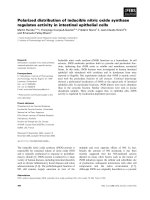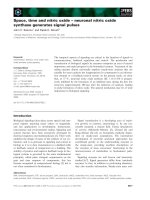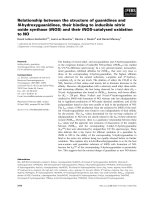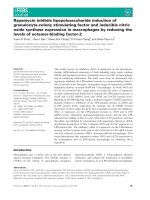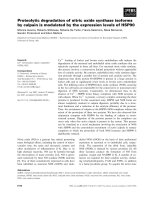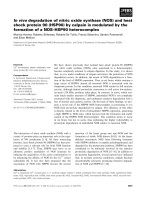Synthesis of guanidino analogues as potential nitric oxide synthase inhibitors
Bạn đang xem bản rút gọn của tài liệu. Xem và tải ngay bản đầy đủ của tài liệu tại đây (1.14 MB, 218 trang )
SYNTHESIS OF GUANIDINO ANALOGUES
AS POTENTIAL NITRIC OXIDE SYNTHASE
INHIBITORS
BONG YONG KOY
NATIONAL UNIVERSITY OF SINGAPORE
2004
SYNTHESIS OF GUANIDINO ANALOGUES
AS POTENTIAL NITRIC OXIDE SYNTHASE INHIBITORS
BONG YONG KOY 2004
SYNTHESIS OF GUANIDINO ANALOGUES
AS POTENTIAL NITRIC OXIDE SYNTHASE
INHIBITORS
BONG YONG KOY
(B.Sc.(Pharm.)(Hons.), NUS)
A THESIS SUBMITTED
FOR THE DEGREE OF DOCTOR OF PHILOSOPHY
DEPARTMENT OF PHARMACY
NATIONAL UNIVERSITY OF SINGAPORE
2004
i
To the beautiful world, those who love me, and those I love.
ii
Acknowledgements
I wish to express my highest gratitude and appreciations towards Dr. Chui Wai Keung
for his invaluable guidance, teaching, advice, support and understandings throughout
the course of the study. Under his supervision, I have learnt a lot and emerged as a
better scientist as well as a better person.
I wish to extend my special thanks to Assoc. Prof. Paul Heng W. S., head of
Department of Pharmacy, for providing support and facilities for carrying out the
study; and the National University of Singapore for providing the research
scholarship.
I also wish to thank Assoc. Prof. Peter Wong T. H. from Department of Pharmacology
for his guidance and advice, as well as providing the facilities to perform the
biological studies.
My appreciations to the laboratory officers in Department of Pharmacy and
Department of Pharmacology, especially Miss Christin Ang L. K., Miss Ng S. E.,
Mdm. Oh T. B., and Mdm. Ting W. L., for their assistance and technical supports.
The support from administrative staff and office support staff are also appreciated.
I am also gratitude for the friendship and support from my fellow friends in
Department of Pharmacy and Department of Pharmacology, notably, but not limited
to, Dr. Jeyanti C. T., Dr. Poon T.Y., Mr. Chen W. S., Mr. Ma X., Miss Lau A. J. and
Miss Lee H. Y. I also wish to thank co-workers Miss Tan Y.K., Mr Ng K. P. and Mr.
Tan J. M. in Pharmacy Department.
Last but not least, I would like to thank my family for their understanding and
emotional support.
iii
Table of Contents
Page
Dedication
i
Acknowledgements
ii
Table of Contents
iii
Summary
vi
Abbreviations
ix
List of Figures
xiii
List of Schemes
xiv
List of Tables
xv
Chapter 1 Nitric Oxide and Nitric Oxide Synthase
1
Nitric Oxide (NO): Properties and Biological Effects
In vivo NO Production: Nitric Oxide Synthase (NOS)
Isoforms of Nitric Oxide Synthase
Physiological Roles of NO and Pathology of NO Overproduction
Inhibition of Nitric Oxide Synthase
X-Ray Crystallographic Structure of NOS
Molecular Probing on NOS Active Site
Binding Sites Around The Active Site of NOS
Chapter 2 NOS Inhibitors Interacting with Guanidino Binding Site
26
Inhibitors with Guanidino Moiety
Amidine and Related Inhibitors
Thiourea and Isothiourea Based Inhibitors
Heterocyclic Based Inhibitors
iv
X-Ray Crystallography of Inhibitors Bound to The NOS Active Site
Chapter 3 Hypothesis, Objectives and Experimental Design
48
Chapter 4 Preliminary Studies on N
1
-Alkylguanidines
52
An Introduction to Guanidines
Synthesis of Guanidines
Synthesis of N
1
-Alkylguanidines
Biological Evaluation of N
1
-Alkylguanidines
Preliminary Protein Visualisation and Analysis
Chapter 5 Solid Phase Organic Synthesis of N
1
,N
2
-dialkylguanidines. Part I.
62
Solid Phase Organic Synthesis (SPOS)
SPOS of Guanidines
Synthesis of Carbodiimides
A Proposed SPOS of N
1
,N
2
-dialkylguanidine
Chapter 6 Solid Phase Organic Synthesis of N
1
,N
2
-dialkylguanidines. Part II.
76
Dehydration of Urea in Solution Phase Reaction
Dehydration of Urea in Solid Phase Reaction
Optimisation of Dehydration of Urea by TosylCl
Optimising Post-Cleavage Workup
Optimised Condition for Synthesising N
1
-Monoalkyl-N
2
-(mono/di)alkylguanidines
Chapter 7 Solid Phase Organic Synthesis of N
1
,N
2
-dialkylguanidines. Part III.
92
Synthesis of N
1
-Monoalkyl-N
2
-(mono/di)alkylguanidines
Biological Evaluation N
1
-Monoalkyl-N
2
-(mono/di)alkylguanidines
Preliminary Protein Visualisation and Analysis
Chapter 8 N
1
-Alkyl-N
2
-nitroguanidines. Part I.
97
v
Synthesis of N
1
-Alkyl-N
2
-nitroguanidines
Biological Evaluation of N
1
-Alkyl-N
2
-nitroguanidines
Chapter 9 N
1
-Alkyl-N
2
-nitroguanidines. Part II.
104
Synthesis of N
1
-Benzyl-N
2
-nitroguanidines
Biological Evaluation of N
1
-Benzyl-N
2
-nitroguanidines
Chapter 10 Further Investigations Using Guanidino-containing Compounds
112
Synthesis and Biological Evaluation of 2-(2-Nitroguanidino)alkanoic acids (NGAA)
Synthesis and Biological Evaluation of 1-Alkyl-4-nitroimino-1,3,5-triazinanes (TZN)
Synthesis and Biological Evaluation of 6-Anilino-4-amino-1,2-dihydro-2,2-dimethyl-
1,3,5-triazine (TZA)
Chapter 11 In Vivo Evaluation
125
Biological (in vivo) Evaluation using PTZ and Rotarod Tests
Chapter 12 Conclusion
135
Materials and Methods
140
Bibliography
165
vi
Summary
Nitric oxide (NO) is produced by three isoforms of nitric oxide synthase
(nNOS, iNOS and eNOS). Depending on the concentration, NO functions as either a
signalling agent or a cytotoxic agent. Overproduction of nNOS-derived NO is
implicated in various neurodegenerative diseases. Hence, selective inhibition nNOS
is desirable.
Numerous NOS inhibitors have been developed, but relatively few are nNOS
selective and none is clinically available yet. Most of the NOS inhibitors contain a
guanidino-mimicking group, which is essential for inhibitor binding. In addition,
several active site interacting groups modify the binding affinity and isoform
selectivity of the inhibitors.
Among the ligand-interacting sites, the region adjacent to the guanidino
binding site (RegG) was less studied. Limited data suggested the involvement of
hydrophobic interaction in RegG; and hydrophobic interaction is the major driving
force in the induced-fitting of a ligand to its binding site. Hence, it was hypothesised
that by exploiting the RegG, selective nNOS inhibition and improved nNOS binding
affinity could be achieved through differently substituted guanidino compounds, and
thus may give rise to useful therapeutic values.
63 compounds from six series of guanidino analogues were synthesised and
evaluated as selective nNOS inhibitor and molecular probe of RegG. While the
syntheses of N
1
-alkylguanidines, N
1
-alkyl-N
2
-nitroguanidines and 1-alkyl-4-
nitroimino-1,3,5-triazinanes (TZN) were rather straight forward, the syntheses of
N
1
,N
2
-dialkylguanidines, 2-(2-nitroguanidino)alkanoic acids (NGAA) and 6-anilino-
4-amino-1,2-dihydro-2,2-dimethyl-1,3,5-triazines (TZA) were challenging and time
vii
consuming, and the reaction optimisation required a good understanding of the
reaction mechanisms.
As compared to N
1
-alkylguanidines, N
1
,N
2
-(disubstituted)guanidines were
more potent and nNOS selective inhibition was achievable, provided the haem iron
(Fe
haem
) interacting groups were able to bind to the size-restricted proximal guanidino
binding site. Both Fe
haem
-interacting N
2
-nitro and N
2
-propyl substituents showed
similar activity profile. For the N
1
-alkyl-N
2
-nitroguanidines, N
1
-benzyl substituent
resulted in enhanced binding affinity and a tendency towards nNOS inhibition. Ring
substituents on the N
1
-benzyl group modified the binding affinity but provided no
improvement in nNOS selectivity. However, with large and hydrophobic aromatic
group, as in compound XXXXII (N
1
-(diphenyl)methyl-N
2
-nitroguanidine), nNOS
selective inhibition was achieved together with improved binding affinity (IC
50
58±5
µM). On the other hand, compounds with charged groups (NGAA, TZN and TZA)
were inactive.
Hence, hydrophobic and π-π stacking interactions were involved in the RegG,
while charged species were not tolerated. The surface topology of the RegG seemed
to be highly conserved provided the RegG-interacting group was not steric
challenging. With bulky, hydrophobic and aromatic RegG-interacting group, the
RegG of nNOS, but not iNOS or eNOS, could undergo induced-conformational
change to accommodate the compound. Thus, nNOS inhibition was achievable via a
size-exclusion mechanism in the RegG.
The lead compound, compound XXXXII, was tested using PTZ and rotarod
tests. Compound XXXXII exhibited partial in vivo nNOS inhibition with minimum
neuromotor side effects. Although compound XXXXII could not prevent the
initialisation of convulsion, it minimised convulsion-induced neurological injuries. In
viii
conclusion, the current study suggested that selective nNOS inhibition could be
achieved via a size-exclusion mechanism in the RegG, and the in vitro nNOS
inhibition was translatable into in vivo neuroprotective activity.
Keywords: Nitric oxide synthase; Selective inhibition; Size-exclusion mechanism;
Neuroprotection; N
1
-(Diphenyl)methyl-N
2
-nitroguanidine.
ix
Abbreviations
%yield
adj
% yield (adjusted to purity)
[ ] concentration term
[Ca
2+
]
i,f
intracellular free Ca
2+
concentration
1,14-BITU N
1
,N
14
-bis((S-methyl)isothioureido)tetradecane (1,14-BITU
1,3-PBITU S,S’-(1,3-phenylenebis(1,2-ethanediyl))bisisothiourea
1,4-PBITU S,S’-(1,4-phenylenebis(1,2-ethanediyl))bisisothiourea
1400W N-(m-(aminomethyl)benzyl)acetamide
BH
4
(6R)-5,6,7,8-tetrahydro-L-biopterin
CaM calmodulin
CBS
α-acid binding site
cNOS constitutive NOS
cpm count per minute
DCM dichloromethane
dGBS distal guanino binding site
DIEA N,N-diisopropyl-N-ethylamine
DMF N,N-dimethylformamide
DMSO N,N-dimethylsulphoxide
DRIFT diffuse reflectance infrared Fourier transformed spectroscopy
DTT DL-Dithiothreitol
DZP diazepam
eNOS endothelial nitric oxide synthase
EPITU S-ethyl-N-phenyl-isothiourea
ESI electron spray ionisation
x
FAD flavin adenine dinucleotide
FMN flavin mononucleotide
FTIR Fourier transformed infrared spectroscopy
GABA
A
γ-aminobutyric acid receptor subtype A
GBS guanino binding site
GMEC global minimum energy conformer
HEPES 4-(2-hydroxyethyl)-1-piperazineethanesulfonic acid
HOONO peroxynitrous acid
IC
50
inhibitory concentration at 50 % inhibition
iNOS inducible nitric oxide synthase
iPrNHG N
1
-isopropyl-N
3
-hydroxyguanidine
K
i
coefficient of inhibition
L-AMMA L-N
G
,N
G
-dimethyl-arginine
L-Arg L-Arginine
L-Cit L-citrulline
L-NA L-N
G
-nitro-arginine
L-NAME L-N
G
-nitro-arginine methyl ester
L-NHA
N
ω
-hydroxy-L-arginine
L-NIO L-N
5
-(1-iminoethyl)-ornithine
L-NMMA L-N
G
-monomethyl-arginine
L-NPA L-N
G
-propylarginine
L-OH-Arg
N
ϕ
-hydroxyl-L-Arginine
MALDI matrix-assisted laser desorption ionisation
NADPH
β-Nicotinamide adenine dinucleotide 2'-phosphate reduced tetrasodium salt
xi
NBS
α-amino binding site
nBuNHG N
1
-butyl-N
3
-hydroxyguanidine
NGAA 2-(2-nitroguanidino)alkanoic acids
NIL L-N-iminoethyllysine
NIO L-N-iminoethylornitine
nNOS neuronal nitric oxide synthase
NO nitric oxide
NOS nitric oxide synthase
PDZ postsynaptic density zipper
pGBS proximal guanino binding site
p-NO
2
PhOCOCl p-nitrophenyl chloroformate
PS polystyrene
PTC phase transfer catalyst
PTZ pentylenetetrazol
RegG region adjacent to GBS
rpm rotation per minute
RS
NO
reactive nitric oxide species
SacBS substrate access channel binding site
SAR structural-activity relationship
SMITUSO4 S-methylisothiouronium sulphate
SMNNITU S-methyl-N-nitroisothiourea
SOD superoxide dismutase
SPOS solid phase organic synthesis
t
½
half-life
xii
TEA N,N,N-triethylamine
TFA trifluoroacetic acid
THF tetrahydrofuran
TosylCl p-methylphenylsulphonyl chloride
TZA 6-anilino-4-amino-1,2-dihydro-2,2-dimethyl-1,3,5-triazines
TZN 1-alkyl-4-nitroimino-1,3,5-triazinane
TZP 1-(substituted)phenyl-4,6-diamino-1,2-dihydro-2,2-dimethyl-1,3,5-triazine
xiii
List of Figures
Figures
Page
1 Schematic representation of NOS structures with bindings sites
for substrates and cofactors.
6
2 Left: Active dimer of NOS (Brookhaven code: 2NSE) consist
s of
two monomers interfacing at the centre. The active site opening
is located on near to the dimer interface, and the catalytic haem
moiety is visible (the right monomer). Right: Cartoon view of
the NOS dimer with the haem (in CPK view) located at the
centre of each monomer.
16
3 Various views of haem, L-Arg and BH
4
in NOS (Brookhaven
code: 2NSE). The Fe
haem
is coordinated by the pyrrole nitrogens
of haem, a cysteine residue, and the guanidino N
ϕ
of the L-Arg.
The haem is slightly concave. The BH
4
is roughly perpendicular
to the haem, which comprises of four pyrrole rings (ring A, B, C
and D), with the ring A located nearest to the BH
4
. Both ring A
and ring D have propionate side chains.
16
4 Binding environment around the guanidino group of L-Arg in
NOS active site (Brookhaven code: 2NSE). Upper left: The N
ϕ
of guanidino group of L-Arg is hydrogen bonded to both Trp and
Glu. The Glu is involved in bidendate interaction with both N
ϕ
and N
ε
of guanidino group. Upper right: The residues Pro, Phe
and Val form a hydrophobic cavity above pyrrole ring C of
haem. The N
η
of guanidino group of L-Arg is pointed towards
the Fe
haem
. Lower: The alkyl chain of L-Arg is in slight non-
bonded contact with Val residue.
17
5 The active site of NOS bound with L-Arg, showing potential
binding sites for inhibitor interaction.
23
6 The often neglected, yet strategically located, RegG.
25
7 Hydrophobic region formed by Val, Met and haem.
61
8 Latency to jumping response for different treatment groups.
128
9 Latency to hind limb extension for different treatment groups.
129
10 Latency to death for different treatment groups.
130
11 Profiles of convulsive events for different treatment groups.
132
xiv
List of Schemes
Schemes
Page
1 The autoxidation of NO.
2
2 Direct and indirect biological effects of NO.
2
3 Two-monooxygenations enzymatic synthesis of NO.
6
4 Synthesis of Guanidine.
54
5 Synthesis of guanidine sulphate via nucleophilic substitution of
SMITUSO4 by amines.
57
6 Synthetic routes to carbodiimide.
70
7 SPOS reaction scheme proposed.
72
8 Proposed mechanism of dehydration of urea by p-
toluenesulphonyl chloride.
82
9 Proposed mechanism of reaction between sulphonic acid with
carbodiimide, resulting in urea formation together with sulphonyl
anhydride.
82
10 The proposed formation of nitrile functional group which may be
derived from either urea or carbodiimide. (X = Cl-, CH
3
PhSO
3
-)
84
11 A proposed scheme depicted the concurrent reactions in the
process of urea dehydration.
86
12 Optimised SPOS of N
1
-monoalkyl-N
2
-(mono/di)alkylguanidine.
90
13 Synthesis of N
1
-alkyl-N
2
-nitroguanidine.
98
14 Synthesis of NGAA.
113
15 Synthesis of TZN.
116
16 Synthesis of TZA.
119
17 Mechanism of Dimroth rearrangement of TZP into TZA under
the presence of nucleophiles, such as hydroxide ions.
121
xv
List of Tables
Tables
Page
1 A brief comparison of the three isoforms of NOS.
8
2
The % Inhibition at 125 µM and IC
50
(µM) of N
1
-
alkylguanidines.
58
3 The yield, purity and %yield (adjusted to purity) (%yield
adj
) of
the N
1
-(mono)alkyl-N
2
-(mono/di)alkylguanidines.
92
4
% Inhibition at 125 µM and the corresponding IC
50
(µM) values
for compounds showing more than 50 % inhibition at 125 µM.
95
5
Screening (%Inhibition at 125 µM) and IC
50
values (µM) of
preliminary library of N
1
-alkyl-N
2
-nitroguanidines.
100
6
Screening (%Inhibition at 125 µM) and IC
50
values (µM) of N
1
-
(substituted)benzyl-N
2
-nitroguanidines.
106
7
%Inhibition at 125 µM for NGAA.
115
8
%Inhibition at 125 µM for TZN.
117
9
%Inhibition at 125 µM for TZA.
123
10 Latencies (seconds) to various convulsive responses for different
treatment groups (n=6).
127
11 Kruskal-Wallis test with Dunn’t test for various convulsive
responses.
127
12 Rotarod test for different treatment groups (n=6).
128
1
Chapter 1 Nitric Oxide and Nitric Oxide Synthase
In 1998, the Nobel Prize in Biology / Medicine was awarded to three
scientists, Robert Furchgott, Louis Ignarro and Ferid Murad
1
. In the same year, Pfizer
Inc. introduced a blockbuster drug, sildenafil (Viagra®), which attracted much public
attention
2
. Both events were related to each other via nitric oxide (NO), which was
named as “Molecule of The Year” in 1992 for being a startlingly simple molecule
uniting neuroscience, physiology, and immunology
3
.
Nitric Oxide (NO): Properties and Biological Effects
NO is a diatomic gaseous molecule which is hydrophobic and uncharged. NO
has low water solubility of 1.9 × 10
-3
M (25 °C, P
NO
1 atm), comparable to other non-
hydrolysable gases such as nitrogen and carbon monoxide
4,5
. NO is a radical with
eleven valence shell electrons, but the occupation of the unpaired electron in the π
antibonding orbital resulted in the higher stability of NO as compared to other
radicals
6
. Although NO is almost inert to water, the half-life (t
½
) of NO is relatively
short in the physiological system (5 to 15 seconds
7
) due to the redox breakdown of
NO, the reactions of NO with O
2
and O
2
–
, and the scavenging systems of NO.
By itself, NO is not a nitrosating agent. The NO-related chemical reactions
are attributable to the redox products (NO
+
and NO
–
) and the autoxidative product
(RS
NO
) of NO
8
. NO is readily oxidised and reduced into NO
+
and NO
–
(conjugate
base of HNO) respectively, but the roles of NO
+
and NO
–
are limited physiologically
9
.
The major physiological nitrosating agent is the reactive nitric oxide species (RS
NO
)
(Scheme 1
9
), which serves as NO
+
donor
9
.
2
NO + O
2
OONO
ONO-ONO
H
2
O
NO
2
2 NO
NO
RS
NO
"N
2
O
3
"
Oxidation
Nitrosation
Scheme 1. The autoxidation of NO.
NO
RS
NO
Transition metals
Radicals
Thiol, amino,
zinc motif,
Cystein, Tyrosine
Redox product
G
u
a
n
y
l
c
y
c
l
a
s
e
,
h
a
e
m
o
g
l
o
b
i
n
,
cytochrome P450,
hypervalent Fe
haem
Eliminate/"neutralise" radicals
Peroxynitrite ONOO
-
Biological target modification
Modification of biomolecules
Scavenger systems
(glutathione, metalloprotein)
Inactivation of enzymatic products
Oxidation
at high [NO]
Scheme 2. Direct and indirect biological effects of NO.
The RS
NO
formation is dependent on [NO] and [O
2
]. Since [O
2
] is high in
physiological systems, NO becomes the limiting reagent. The kinetics of RS
NO
formation has a second order dependency on [NO]
10,11
. At low [NO], the t
½
of NO is
long. Thus NO remains intact for a longer duration and responsible for the biological
effects at low [NO]. In contrary, at high [NO], the t
½
of NO is short. NO is rapidly
oxidised into RS
NO
, which is responsible for the biological effects observed at high
[NO]. As a result, the second order [NO] dependency separates the direct and indirect
biological effects of NO. The direct biological effects of NO are attributed to NO
itself while the indirect biological effects of NO are attributed to the oxidative
products of NO (mainly the RS
NO
) (Scheme 2).
3
The direct biological effects of NO are resulted from the reactions of NO with
metals and other radicals. NO has an affinity to react with some transition metals
such as Fe
2+
and Fe
3+
to give metal-NO
+
adducts
9,12
. Hence, NO interacts with
various metalloproteins such as guanyl cyclase
13
, cytochrome P450 enzymes
14
,
haemoglobin
15
, and myoglobin
15
. The interaction between NO and guanyl cyclase is
the basis for physiological effects of NO. The guanyl cyclase is stimulated by NO
and produces the second messenger cGMP, which initiates a cascade of downstream
signalling events. Besides that, through the interruption of the Fe-O
2
complex
formation and the subsequent oxidative reactions, NO reversibly inhibits the
cytochrome P450 enzymes. NO also reacts with oxyhaemoglobin and oxymyoglobin
to give methaemoglobin and metmyoglobin respectively, with the generation of
nitrate. Hence, the haemoglobin and the intact red blood cells are NO scavengers that
prevent NO related oxidative damages. Furthermore, the affinity of NO towards high
valent Fe(IV/V)
16
, an intermediary product of peroxide-induced toxicity, also helps to
minimise peroxide related injuries.
NO reacts with various radicals, such as nitrogen dioxide
9
, hydroxyl radical
17
,
peroxide radical, superoxide (O
2
–
) radical, alkyl radical, alkoxy radical, and
alkylperoxide radicals
18
, thus consuming and inactivating the radicals.
Physiologically the most important reaction is the formation of peroxynitrite (OONO
–
) from NO and O
2
–
. The formation of OONO
–
, which is 5 times faster than
superoxide dismutase (SOD)
9
, can be both detoxifying
19
and potentially deleterious
20
.
Under basic pH, the OONO
–
is relatively inert and slowly dismutates into nitrite and
oxygen
21
, thus serves to inactivate O
2
–
. Under acidic pH, OONO
–
is protonated as
peroxynitrous acid (HOONO), which either self-isomerises into nitrate or oxidises
4
various biological substrates. Since HOONO is a weaker oxidant as compared to O
2
–
,
less overall oxidative damage is resulted as compared to O
2
–
9,22
.
Other than being an oxidant, HOONO also exhibits destructive roles through
reaction with sulfhydryl (–SH) to give disulfide
23
, and in the presence of metal ions,
nitriation of tyrosine
24
. As a result, the structures, and thus the activities, of the
proteins are modified. Nevertheless, the formation (which is in competition with high
level of SOD) and oxidising effect of OONO
–
(which is scavenged by SOD and GSH)
are tightly regulated, and thus the toxicity due to OONO
–
is rather limited.
The indirect effect of NO is mainly attributed to RS
NO
9
. In aqueous system,
the primary RS
NO
is NO
X
, which is postulated to have the empirical formula of
N
2
O
3
25
. In physiological system, NO
X
is rapidly hydrolysed to nitrite
9
. The aqueous
hydrolysis of NO
X
is in competition with the nitrosation and oxidation reactions, in
which NO
X
nitrosates, and thus modifies the functions of, amine- and thiol-containing
biomolecules, as well as oxidizes redox-active complexes
9,10,26
. RS
NO
covalently
modifies the thiol moieties or zinc motifs of various enzymes, such as ribonucleotide
reductase
27
, protein kinase C
28
, glyceraldehydes-3-phophate dehydrogenase
29
, DNA
alkyltransferase
30
, and Fpq protein
31
, and thus inhibiting the enzymes. In addition,
NO
X
reacts with thiol groups in glutathione, which is an important NO scavenger, to
give S-nitrosothiol adducts
26
. The thiol-rich metallothionein also provides scavenging
protection against NO
X
toxicity
32
. On the other hand, instead of acting directly on
enzyme, the NO
X
is shown to oxidise the redox-active enzymatic products. For
example, although the xanthine oxidase activity is not affected by NO
X
, the enzymatic
effect is limited as the O
2
–
that is produced is rapidly intercepted by NO
X
9,19,33,34
.
The interplay between direct and indirect effects of NO is [NO] dependence
9
.
Since the [NO] changes as the NO diffuses away from the NO producing source, the
5
observed NO effects are varied
35
. Generally at low [NO] on a cellular scale, the
diffusion diameter is 150 – 300 µm and a rather wide area of cells (typical cell radius
is 4 – 15 µm) is regulated to varying degree
35
. In cases of high local [NO] production,
the destructive damage is rather localised at the high [NO] producing source, and
normal regulatory effects of NO are observed at the peripheral low [NO] regions as
the NO diffuses away
35
.
As a result, the overall in vivo effect of NO is regulated by the reactivity,
selectivity and diffusibility of NO
35
. NO is produced in vivo under both constitutive
and inducible mode
9,36
. In constitutive mode, NO is produced in concentration of
picomolar range, at which regulatory direct biological NO effects are involved. On
the other hand, micromolar range of [NO] is produced under inducible mode, and the
high [NO] is associated with mainly destructive indirect NO biological effects.
In vivo NO Production: Nitric Oxide Synthase (NOS)
NO is produced in human body by a family of enzymes known as nitric oxide
synthase (NOS; EC1.14.13.39). NOS oxidises L-arginine (L-Arg) into NO and L-
citrulline (L-Cit). There are three isoforms of NOS, the neuronal NOS (nNOS),
inducible NOS (iNOS) and endothelial NOS (eNOS), each with different structures,
expression modes, regulations, localisations and functions.
When NOS is represented as a single peptidic chain, it has a reductase domain
on its C-terminus and an oxygenase domain on its N-terminus (Figure 1). The
reductase domain bears more than 50% sequence similarity with NADPH-cytochrome
P450 reductases from different species
36
. The electrons produced through NADPH
oxidation are transferred through flavin adenine dinucleotide (FAD) to flavin
mononucleotide (FMN), and subsequently into the oxygenase domain. The
oxygenase domain consists of binding sites for L-Arg, (6R)-5,6,7,8-tetrahydro-L-
6
biopterin (BH
4
), and iron protoporphyrin IX (haem)
37,38,39
. The haem is the catalytic
site for oxidising the substrate L-Arg, and it shows a reduced CO (carbon monoxide)
difference spectrum characteristic of cytochrome P450 enzymes
40,41,42
. In the absence
of L-Arg and BH
4
, the Fe
haem
exists predominantly in six-coordinated low spin
inactive form (λ
max
at 420 nm), but it is activated to the five-coordinated high spin
form (λ
max
at 450 nm) in the presence of L-Arg and BH
4
. The role of BH
4
has been
controversial
36
. It has been suggested to act as allosteric modulator
43
, high-spin state
promoter
41
, protein stabilizer
44
and activity enhancer
45
. Interconnecting the reductase
and oxygenase domains is the calmodulin (CaM) binding domain
36
. The enzyme is
inactive without CaM, the binding of which is essential for intra-reductase and
reductase-oxygenase electron transfers, and thus the initiation of the enzyme catalytic
machinery
46,47,48
.
N’–
NADPH FAD FMN CaM BH
4
Haem L-Arg
–C’
Reductase domain Oxygenase domain
Figure 1. Schematic representation of NOS structures with bindings sites for
substrates and cofactors.
NADPH
O
2
1/2 NADPH
O
2
+
NO
L-Arg
L-OH-Arg L-Cit
H
3
N
CH
COO
HN
C
NH
2
NH
2
H
3
N
CH
COO
HN
C
NH
2
H
N OH
H
3
N
CH
COO
HN
C
NH
2
O
α β
γ
δ
ε
ζ
η
ω
Scheme 3. Two-monooxygenations enzymatic synthesis of NO.
Despite having a self-sufficient redox system on single monomer, NOS is
active only in the homodimeric form. The dimerisation enables proper orientation of
7
the functional domains, thus allowing efficient inter-domain electron transfer
49,50
. As
a catalytically active NOS dimer, an electron is transferred from the reductase domain
of one monomer into the oxygenase domain of the other monomer. It was found that
both haem and BH
4
are essential for the formation and stabilization of the dimeric
conformation
44,51,52
.
The catalytically active NOS produces NO via oxidation of L-Arg, with
stoichiometric production of L-Cit
36
(Scheme 3). The NO is synthesised through two
constitutive steps. The first step is the monooxygenation of L-Arg, which results in
the hydroxylation of the N
ω
of the guanidino moiety
53
. In order to oxidise 1 mole of
L-Arg, 1 mole of NADPH (provides 2 moles of electrons) and 1 mole of O
2
are
required. This is a classical cytochrome P450 mixed-function hydroxylation.
Initially, an electron derived from NADPH reduces the Fe
haem
, which is subsequently
bound to O
2
. After that, a second NADPH-derived electron reduces the bound O
2
to
give Fe
haem
-O
2(reduced)
. Subsequently a proton is abstracted from the L-Arg guanidino
moiety to give prooxo-Fe
haem
complex, which loses a water molecule to generate
hypervalent oxo-Fe radical. This hypervalent oxo-Fe radical is responsible for the
radical-based hydroxylation of the guanidino moiety of L-Arg, giving rise to the
product N
ω
-hydroxyl-L-Arg (L-NHA)
54
.
With the L-NHA tightly bound at the NOS active site, the second
monooxygenation reaction occurs. The reaction requires 0.5 mole of NADPH
(provides 1 moles of electrons) and 1 mole of O
2
for every 1 mole of L-NHA, and
generates equimolar of L-Cit and NO as final products
54
. This single NADPH-
derived electron monooxygenation step is unique and different from other reported
monooxygenases. The reaction is initiated by the reduction of Fe
haem
by an NADPH-
derived electron. Another reducing electron is derived from the L-NHA
55
, and results

